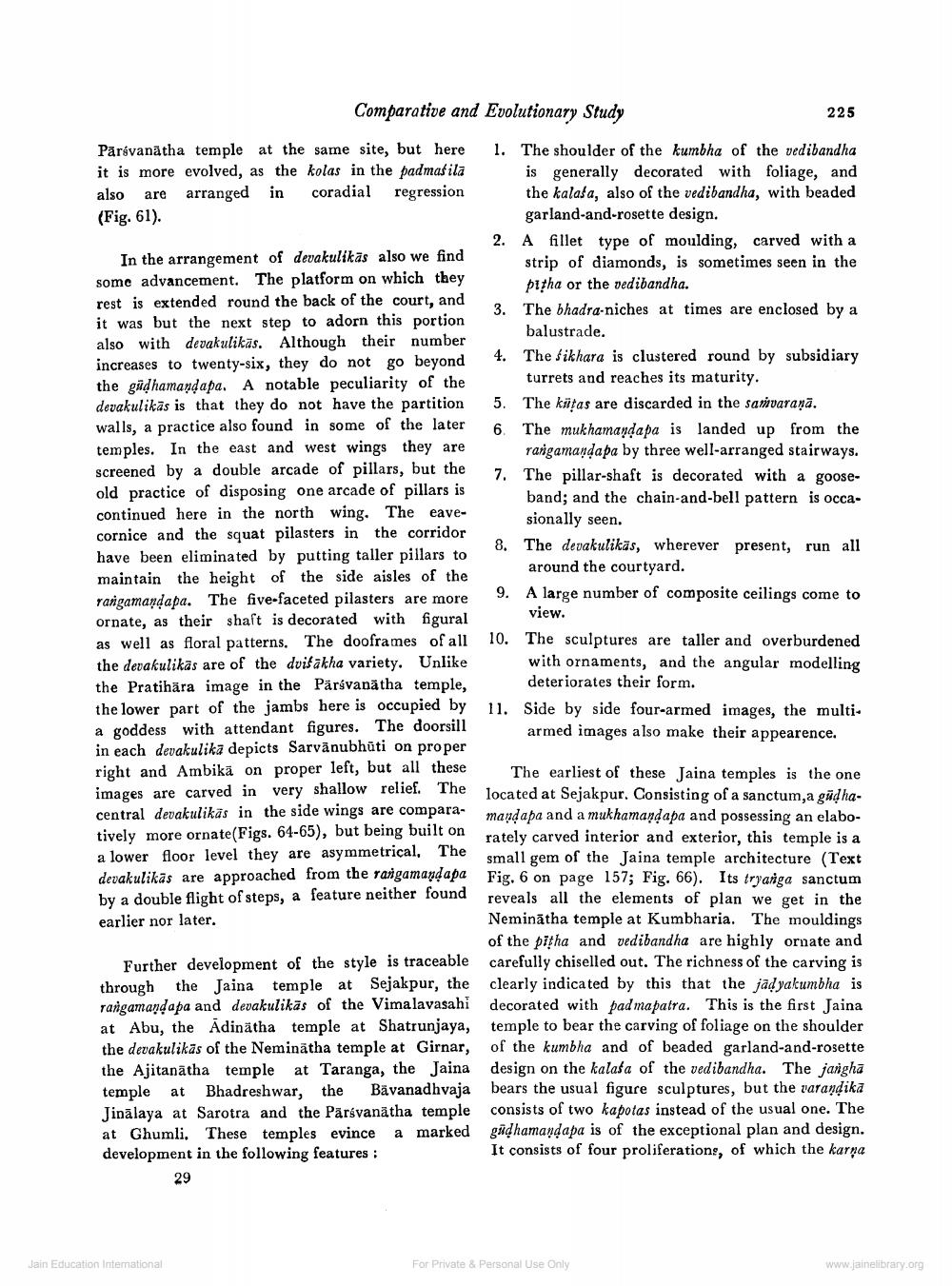________________
Comparative and Evolutionary Study
225
4.
The
Pārsvanatha temple at the same site, but here 1. The shoulder of the kumbha of the vedibandha it is more evolved, as the kolas in the padmašila is generally decorated with foliage, and also are arranged in coradial regression the kalaša, also of the vedibandha, with beaded (Fig. 61).
garland-and-rosette design.
2. A fillet type of moulding, carved with a In the arrangement of devakulikās also we find
strip of diamonds, is sometimes seen in the some advancement. The platform on which they
pitha or the vedibandha. rest is extended round the back of the court, and
3. The bhadra-niches at times are enclosed by a it was but the next step to adorn this portion
balustrade. also with devakulikās. Although their number increases to twenty-six, they do not go beyond
The Sikhara is clustered round by subsidiary the güdhamandapa. A notable peculiarity of the turrets and reaches its maturity. devakulikās is that they do not have the partition 5. The kūtas are discarded in the samvaraņā. walls. a practice also found in some of the later 6. The mukhamandaba is landed up from the temples. In the east and west wings they are rarigamanda pa by three well-arranged stairways. screened by a double arcade of pillars, but the
7. The pillar-shaft is decorated with a gooseold practice of disposing one arcade of pillars is
band; and the chain-and-bell pattern is occacontinued here in the north wing. The eave
sionally seen. cornice and the squat pilasters in the corridor
8. The devakulikās, wherever present, run all have been eliminated by putting taller pillars to
around the courtyard. maintain the height of the side aisles of the rangamandapa. The five-faceted pilasters are more
9. A large number of composite ceilings come to ornate, as their shaft is decorated with figural
view. as well as floral patterns. The dooframes of all 10. The sculptures are taller and overburdened the devakulikās are of the dvišakha variety. Unlike with ornaments, and the angular modelling the Pratihāra image in the Pārsvanätha temple, deteriorates their form. the lower part of the jambs here is occupied by 11. Side by side four-armed images, the multia goddess with attendant figures. The doorsill
armed images also make their appearence. in each devakulika depicts Sarvānubhūti on proper right and Ambikā on proper left, but all these
The earliest of these Jaina temples is the one images are carved in very shallow relief. The located at Sejakpur. Consisting of a sanctum,a güdhacentral devakulikäs in the side wings are compara
mandapa and a mukhamandapa and possessing an elabotively more ornate(Figs. 64-65), but being built on rately carved interior and exterior, this temple is a a lower floor level they are asymmetrical. The
small gem of the Jaina temple architecture (Text devakulikās are approached from the rangamandapa Fig. 6 on page 157; Fig. 66). Its tryaniga sanctum by a double flight of steps, a feature neither found
reveals all the elements of plan we get in the earlier nor later.
Neminātha temple at Kumbharia. The mouldings
of the pitha and vedibandha are highly ornate and Further development of the style is traceable carefully chiselled out. The richness of the carving is through the Jaina temple at Sejakpur, the clearly indicated by this that the jadyakumbha is Tangamandapa and devakulikās of the Vimalavasahi decorated with bad mapatra. This is the first Jaina at Abu, the Adinātha temple at Shatrunjaya, temple to bear the carving of foliage on the shoulder the devakulikās of the Neminātha temple at Girnar, of the kumbha and of beaded garland-and-rosette the Ajitanātha temple at Taranga, the Jaina design on the kalasa of the vedibandha. The jangha temple at Bhadreshwar, the Bāvanadhvaja bears the usual figure sculptures, but the varandika Jinālaya at Sarotra and the Parsvanātha temple consists of two kapotas instead of the usual one. The at Ghumli. These temples evince a marked gâdhamandapa is of the exceptional plan and design. development in the following features :
It consists of four proliferations, of which the karna
29
Jain Education International
For Private & Personal use only
www.jainelibrary.org




